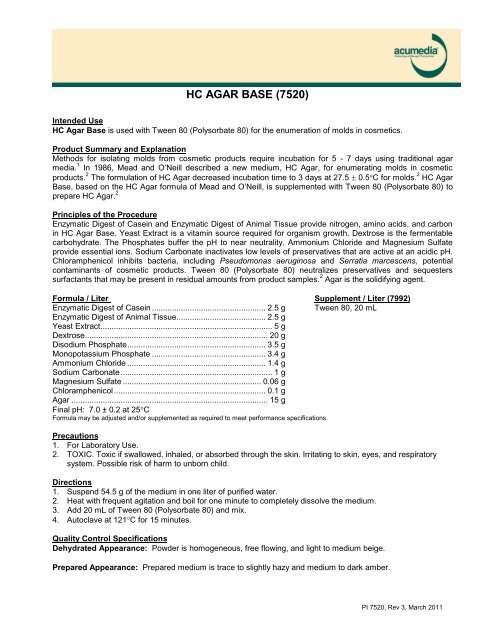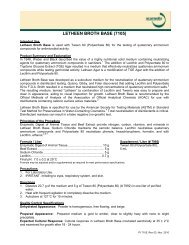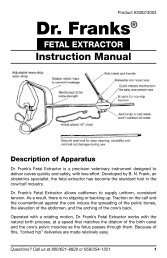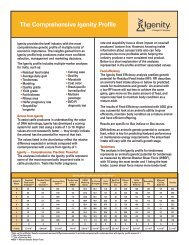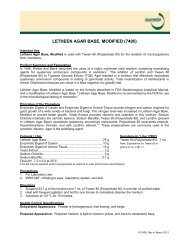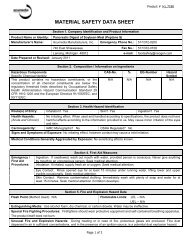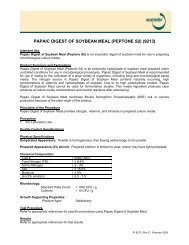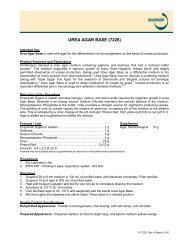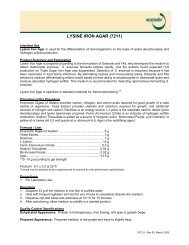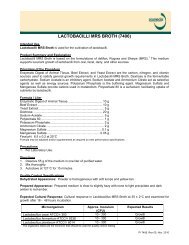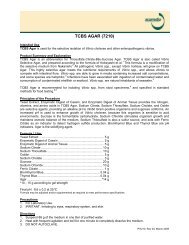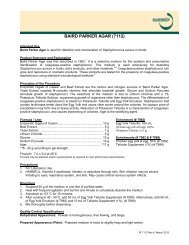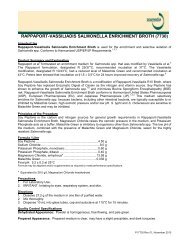HC Agar Base — 7520
HC Agar Base — 7520
HC Agar Base — 7520
You also want an ePaper? Increase the reach of your titles
YUMPU automatically turns print PDFs into web optimized ePapers that Google loves.
<strong>HC</strong> AGAR BASE (<strong>7520</strong>)<br />
Intended Use<br />
<strong>HC</strong> <strong>Agar</strong> <strong>Base</strong> is used with Tween 80 (Polysorbate 80) for the enumeration of molds in cosmetics.<br />
Product Summary and Explanation<br />
Methods for isolating molds from cosmetic products require incubation for 5 - 7 days using traditional agar<br />
media. 1 In 1986, Mead and O’Neill described a new medium, <strong>HC</strong> <strong>Agar</strong>, for enumerating molds in cosmetic<br />
products. 2 The formulation of <strong>HC</strong> <strong>Agar</strong> decreased incubation time to 3 days at 27.5 0.5C for molds. 2 <strong>HC</strong> <strong>Agar</strong><br />
<strong>Base</strong>, based on the <strong>HC</strong> <strong>Agar</strong> formula of Mead and O’Neill, is supplemented with Tween 80 (Polysorbate 80) to<br />
prepare <strong>HC</strong> <strong>Agar</strong>. 2<br />
Principles of the Procedure<br />
Enzymatic Digest of Casein and Enzymatic Digest of Animal Tissue provide nitrogen, amino acids, and carbon<br />
in <strong>HC</strong> <strong>Agar</strong> <strong>Base</strong>. Yeast Extract is a vitamin source required for organism growth. Dextrose is the fermentable<br />
carbohydrate. The Phosphates buffer the pH to near neutrality. Ammonium Chloride and Magnesium Sulfate<br />
provide essential ions. Sodium Carbonate inactivates low levels of preservatives that are active at an acidic pH.<br />
Chloramphenicol inhibits bacteria, including Pseudomonas aeruginosa and Serratia marcescens, potential<br />
contaminants of cosmetic products. Tween 80 (Polysorbate 80) neutralizes preservatives and sequesters<br />
surfactants that may be present in residual amounts from product samples. 2 <strong>Agar</strong> is the solidifying agent.<br />
Formula / Liter Supplement / Liter (7992)<br />
Enzymatic Digest of Casein ................................................... 2.5 g Tween 80, 20 mL<br />
Enzymatic Digest of Animal Tissue........................................ 2.5 g<br />
Yeast Extract ............................................................................. 5 g<br />
Dextrose .................................................................................. 20 g<br />
Disodium Phosphate .............................................................. 3.5 g<br />
Monopotassium Phosphate ................................................... 3.4 g<br />
Ammonium Chloride .............................................................. 1.4 g<br />
Sodium Carbonate .................................................................... 1 g<br />
Magnesium Sulfate .............................................................. 0.06 g<br />
Chloramphenicol .................................................................... 0.1 g<br />
<strong>Agar</strong> ........................................................................................ 15 g<br />
Final pH: 7.0 ± 0.2 at 25C<br />
Formula may be adjusted and/or supplemented as required to meet performance specifications.<br />
Precautions<br />
1. For Laboratory Use.<br />
2. TOXIC. Toxic if swallowed, inhaled, or absorbed through the skin. Irritating to skin, eyes, and respiratory<br />
system. Possible risk of harm to unborn child.<br />
Directions<br />
1. Suspend 54.5 g of the medium in one liter of purified water.<br />
2. Heat with frequent agitation and boil for one minute to completely dissolve the medium.<br />
3. Add 20 mL of Tween 80 (Polysorbate 80) and mix.<br />
4. Autoclave at 121C for 15 minutes.<br />
Quality Control Specifications<br />
Dehydrated Appearance: Powder is homogeneous, free flowing, and light to medium beige.<br />
Prepared Appearance: Prepared medium is trace to slightly hazy and medium to dark amber.<br />
PI <strong>7520</strong>, Rev 3, March 2011
Expected Cultural Response: Cultural response on <strong>HC</strong> <strong>Agar</strong> <strong>Base</strong> supplemented with Tween 80 incubated<br />
aerobically at 27 0.5C and examined for growth after 2 - 7 days incubation.<br />
Microorganism Approx. Inoculum (CFU) Expected Results<br />
Aspergillus niger ATCC® 16404 Point Inoculation Growth<br />
Bacillus subtilis ATCC® 9372 300 - 1000 Inhibited<br />
Candida albicans ATCC® 10231 10 - 300 Fair to excellent<br />
Escherichia coli ATCC® 25922 300 - 1000 Inhibited<br />
Penicillium roquefortii ATCC® 10110 Point Inoculation Growth<br />
Pseudomonas aeruginosa ATCC® 27853 300 - 1000 Marked to complete inhibition<br />
Staphylococcus aureus ATCC 25923 300 - 1000 Inhibited<br />
The organisms listed are the minimum that should be used for quality control testing.<br />
Test Procedure<br />
1. Process each specimen as appropriate and inoculate directly onto surface of the medium. 1 Inoculate<br />
duplicate plates.<br />
2. Incubate plates aerobically at 27 0.5C.<br />
3. Examine plates for growth and recovery after 72 hours incubation.<br />
4. Count mold colonies from duplicate plates and record average count as mold count per gram or milliliter of<br />
sample.<br />
Results<br />
Mold colonies should yield good growth and recovery. Bacteria should be inhibited.<br />
Storage<br />
Store sealed bottle containing dehydrated medium at 2 - 30C. Once opened and recapped, place container in a<br />
low humidity environment at the same storage temperature. Protect from moisture and light by keeping<br />
container tightly closed.<br />
Expiration<br />
Refer to expiration date stamped on container. The dehydrated medium should be discarded if not free flowing,<br />
or if appearance has changed from the original color. Expiry applies to medium in its intact container when<br />
stored as directed.<br />
Limitations of the Procedure<br />
1. Due to nutritional variation, some strains may be encountered that grow poorly or fail to grow.<br />
2. The 27 0.5C incubation temperature is critical for obtaining statistically significant mold counts after three<br />
days.<br />
Packaging<br />
<strong>HC</strong> <strong>Agar</strong> <strong>Base</strong> Code No. <strong>7520</strong>A 500 g<br />
<strong>7520</strong>B 2 kg<br />
<strong>7520</strong>C 10 kg<br />
Tween 80 7992 100 mL<br />
References<br />
1. Hitchins, A. D., T. T. Tran, and J. E. McCarron. 1995. Microbiological methods in cosmetics. In Bacteriological analytical<br />
manual, 8 th ed AOAC International, Gaithersburg, MD.<br />
2. Mead, C., and J. O’Neill. 1986. A three-day mold assay for cosmetics and toiletries. J. Soc. Cosmet. Chem. 37:49-57.<br />
Technical Information<br />
Contact Acumedia Manufacturers, Inc. for Technical Service or questions involving dehydrated culture media preparation or<br />
performance at (517)372-9200 or fax us at (517)372-2006.<br />
PI <strong>7520</strong>, Rev 3, March 2011


